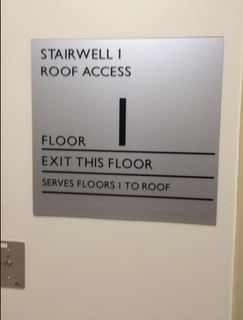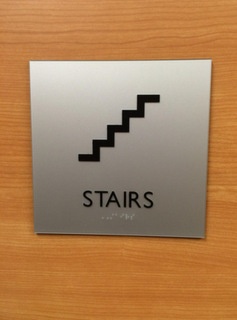The Americans with Disabilities Act (ADA) went into effect in 1992 with the goal of making buildings accessible to people of all abilities. They are regulations governing how signs on the interior and exterior of your facility must appear and how they should be mounted. In fact, the rules state that signs must have pictorial, tactile, verbal, and symbolic information.

It is crucial that your business knows about the scope and details of the requirements in order to be in compliance. When you follow the guidelines, you will clearly communicate information to people of all abilities as well as help them navigate our venue. Fortunately, The Sign Center offers ADA signs for North Jersey.
What Signage Must Comply with the ADA?
Not all signs in your facility are required to be ADA compliant. For practical purposes, there are exceptions to the regulations. To give you an idea of what signs must comply with the ADA, we have put together some prime examples:
- Signs that denote exit routes, bathrooms, and serve other directional purposes
- Markers that designate conference rooms, room numbers, and other permanent rooms
- Informational signage situated in the lobby or other functional areas of your building
Of course, there are plenty more signs in your venue than the ones listed above. The compliance requirements are not as strict for these other ones. For instance, signs used in window displays, for promotions, or for other temporary purposes do not usually have to comply with ADA standards. Also outside of the guidelines are semi-permanent building directories that change as businesses move in and out.
What Are the Specifics of the ADA?

The main focus of the guidelines set forth for ADA signs in North Jersey is that they need to be readable. Readability allows people of all abilities to experience better accessibility. The kinds of fonts and the size of the copy are regulated. For example, typefaces should be sans serif, simple, and non-decorative. To make signs usable for tactile readers, the tactile letters must be raised to a height of 5/8” but less than 2”. You also need to add Grade 2 Braille to your regular signs.
A contrast of at least 70 percent between backgrounds and letters is also required. This means you need to use light-colored letters on a dark background or dark-colored letters on a light background. Additionally, the signage must use non-glare and non-reflective materials. You help older adults with vision impairments navigate your building when you do this.
Sign placement is also important. Interior office signs that are used to identify rooms should be mounted on the side of the door latch near the entrances to rooms. This is to assist blind guests in finding and reading signs.
When you do not follow the guidelines set out by the ADA, you leave yourself open to unhappy customers, fines, complaints, and lawsuits. Even your clients who do not have disabilities may be turned off by your organization’s lack of accommodations.
If you are ready to improve the wayfinding in your facility, contact The Sign Center today for a free consultation!







